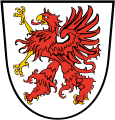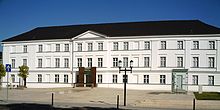Western Pomerania

Western Pomerania is the smaller part of the former Prussian province of Pomerania , located west of the Oder and almost entirely remaining in Germany . Western Pomerania , on the other hand, the larger part to the east of the Oder went completely to Poland. Shortly after the Second World War , Pomerania was divided between Germany and Poland by the victorious powers . Only the so-called Stettiner Zipfel and the former Pomeranian provincial capital Stettin came to Poland from Western Pomerania . Stettin ( Polish: Szczecin ) is growing today Metropolitan area and the capital of the West Pomeranian Voivodeship .
Together with Mecklenburg , the largest part of Western Pomerania today forms the state of Mecklenburg-Western Pomerania . It lies in its eastern part and covers about a third of its area. Western Pomerania is located in north-east Germany and the southern Baltic Sea area , borders Poland in the east, Mecklenburg in the west and Brandenburg in the south-east . A small part of Western Pomerania around the town of Gartz is now in Brandenburg. The most important cities of Western Pomerania are Stralsund and Greifswald , which together form a regional center . Rostock as a regiopole and the metropolitan regions of Hamburg and Berlin have an impact on the region, as does the Öresund region via the Baltic Sea and Stettin as a cross-border conurbation .
The region is known as a place to live and a holiday destination for its abundance of water. The extensive Baltic Sea coast with the numerous seaside resorts , especially on the two largest German islands Rügen and Usedom , as well as the species-rich lagoons z. B. in the national park Vorpommersche Boddenlandschaft with rich nature.
The historical area of Western Pomerania largely coincides with the city of Stettin and the Powiat Policki in Poland as well as the districts of Western Pomerania-Rügen and Western Pomerania-Greifswald in Germany. As the Regional Planning Association for Western Pomerania, these two districts now form one of four sub-areas for regional planning in Mecklenburg-Western Pomerania.
The Pommernlied plays as a regional anthem still a role in the regional songs. It was created around 1850 and goes back to the theologian Gustav Adolf Pompe .
Concept and limits

Western Pomerania, also known as Western Pomerania until the 19th century , has been understood (in contrast to Western Pomerania ) since the Peace of Westphalia in 1648 to mean the part of Pomerania west of the Oder , i.e. - unlike today - including the capital Stettin . Through the arbitrarily drawn border , which leaves the Oder from Mescherin and leads further west, the area between it and the Oder including the island of Wollin , the city of Swinoujscie on Usedom and Stettin and the so-called Stettiner Zipfel came to Poland . The latter is so named by the German population displaced from there to make it clear that this part of Western Pomerania historically did not belong to Western Pomerania, just because it has belonged to Poland since the war. The term Western Pomerania is now generally used for the German part of Pomerania.
The former border between Mecklenburg and Pomerania has largely been lost since the administrative reform of 1952 in the GDR . With the district reform in 2011 , the former border line was only partially approximated again. In its course it lives on as the border between the Protestant church districts of Mecklenburg and Pomerania in the northern church and between the Catholic archdioceses of Hamburg and Berlin to this day.
The original course of the historical border between Mecklenburg and Pomerania, which runs largely through the Mecklenburg-Western Pomerania border valley , is described below:
“From the Fischland west of Ahrenshoop to the south, crosses the Saaler Bodden to the Recknitz estuary , separates the Mecklenburg Ribnitz from the Pomeranian Damgarten, leads in the middle of Recknitz and Trebel to north of Demmin , to meet the Peene west of Demmins , leads along this to the Kummerower See , crosses it and leaves it at the Peene near Moorbauer. East of Basepohl it runs through the Augraben , which it leaves at Hasseldorf in an easterly direction. From Altenhagen it runs in a southerly direction to the outflow of the Kastorfer See and from there to the east until it reaches the Tollensee lowlands at Lebbin . It follows the Tollense in a northerly direction to Treptower Werder , then continues along the border ditch, first to the east, then to the north until it joins the Großer Landgraben . In the Landgraben it runs to the Lübkowse near Charlottenhorst , from there to the Weißen Graben in the Friedlander Große Wiese , which it follows to the Galenbecker See . After all, it meets the state border with Brandenburg near Heinrichswalde . "
Until 1937, the exclave Zettemin near Stavenhagen belonged to the province of Pomerania. By the national government, Hitler issued Greater Hamburg Act it belongs since April 1, 1937 but to Mecklenburg. In other respects, the border, which has actually been fixed since the late Middle Ages, was only finally determined in detail by state treaties between Mecklenburg and Prussia in the 19th century. In Wolde near Altentreptow the border ran right through the town until 1873.
Duchy of Pommern-Wolgast from 1541 largely identical to Western Pomerania
Today's county boundaries
For the district reform in 1994 there were drafts to revive the border between Mecklenburg and Pomerania with the new districts. However, these were not implemented.
With the district reform in 2011 , the historical boundaries were approached a little closer, but without reproducing the exact course.
The name of the region of Western Pomerania can now be found in two districts:
The old state border today runs through the district of Vorpommern-Rügen , the smaller western part of which, including the Ribnitz district of Ribnitz-Damgarten, actually belongs to Mecklenburg, and through the Mecklenburg Lake District , whose north-eastern part is between Demmin and Altentreptow - the so-called Demminer Land - historically it belongs to Western Pomerania, as well as briefly through the district of Vorpommern-Greifswald , where a small area in the southwest - the Friedländer Große Wiese and Gehren (now part of Strasburg ) - was actually part of Mecklenburg.
District reform 2011 with borders, oriented closer to the historical border line Mecklenburg / Vorpommern.
geography
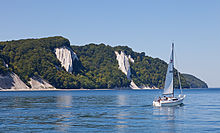
Vorpommern is mainly characterized by its long coastline, which takes up most of the coast of Mecklenburg-Vorpommern . A distinctive “double coast” is typical, with offshore islands separating so-called lagoon from the open sea, which in this form represent a unique landscape. With Rügen and Usedom , the two largest German islands belong to Western Pomerania.
The largest city in Western Pomerania is the Hanseatic city of Stralsund , which was once mighty during the Hanseatic era . Even today it is the most economically important city. The Hanseatic city of Greifswald , about 35 km from Stralsund, is the intellectual and judicial center because of the many regional jurisdictions and the resident old university .
The cities of Stralsund and Greifswald together form the second largest regional center in Mecklenburg-Western Pomerania after Rostock. In addition, the area has the second highest population density of the four planning regions in the country.
There are two national parks and three nature parks in Western Pomerania:
The eastern shore region of the Kummerower See belongs to the nature park Mecklenburgische Schweiz and Kummerower See .
history
The name Pomerania is the Germanized form of Pomorje and is of Slavic origin: po more - "by the sea" .
The name Western Pomerania goes back to the second division of Pomerania into the Duchies of Pommern-Wolgast (Western Pomerania) and Pomerania-Stettin (Western Pomerania) in 1532. While in 1295 there was still a division into a northern (Pommern-Wolgast) and a southern duchy (Pomerania-Stettin), a western and an eastern part of the country were created for the first time in 1532. After the Peace of Westphalia (1648), Western Pomerania comprised the part of Pomerania belonging to the Kingdom of Sweden, including the entire mouth of the Oder with the city of Stettin and the old bishopric of Cammin .
The part of Western Pomerania south of the Peene with Stettin and the Oder estuary islands of Usedom and Wollin became part of Prussia in 1720 . The name " Altvorpommern " was later established for this . The northern part, on the other hand, was under Danish military administration from 1715 to 1721, but belonged to Sweden ( Swedish-Pomerania , also "New Western Pomerania") until the Kiel Peace of 1814 , then was awarded to Denmark as a replacement for Norway, but this never had practical consequences. because Denmark could not pay the war indemnity demanded by Sweden. Therefore negotiations continued at the Congress of Vienna and the area became part of Prussia in the autumn of 1815.
After the Second World War , Western Pomerania was largely part of the Soviet occupation zone and was united with Mecklenburg to form the state of Mecklenburg-Western Pomerania. In 1947, the country was renamed Mecklenburg on the orders of the SMAD in order to remove the term Pomerania from the official language. After the founding of the GDR in 1949, during the administrative reform in 1952, the region of Western Pomerania became predominantly part of the Rostock and Neubrandenburg districts . The southern tip came to the Frankfurt (Oder) district and largely coincides with today's Gartz (Oder) office .
In 1990 Western Pomerania became part of the state of Mecklenburg-Western Pomerania . Since the new formation of the federal states in the GDR was carried out along the existing district borders, the actually Pomeranian Gartz remained in Brandenburg, while, for example, the Uckermark - and thus actually Brandenburg - Strasburg decided in a referendum to remain in the Western Pomerania region in Mecklenburg-Western Pomerania .
The Euroregion Pomerania was founded as part of European cooperation in order to bring the separate regions of Western and Eastern Pomerania closer together again . Poland's accession to the Schengen area and the country's planned accession to the euro area also help to overcome the dividing line between the two parts of Pomerania.
With the district reform in 2011 , the administrative structure in Mecklenburg and Western Pomerania was completely reorganized. The Mecklenburg-Pomeranian mixed district of Demmin was divided into two and most of Western Pomerania was divided into the two new districts of Western Pomerania-Rügen and Western Pomerania-Greifswald . During this territorial reform, too, the borderline between Pomerania and Mecklenburg, which had remained almost unchanged for over 600 years, was largely disregarded, although it would have been possible to take the exact course into account.
education
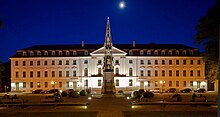
The University of Greifswald , founded in 1456 by the Pomeranian dukes ( Greifen ) and richly endowed, is the second oldest university in the Baltic Sea region after Rostock and one of the oldest German universities. Because of the geopolitical location and the connections to Sweden in the time of Swedish Pomerania , the university was an important cultural bridge to the Scandinavian countries. For the province of Pomerania it was also the (only) state university. Well-known Greifswald professors of recent times are the surgeon Ferdinand Sauerbruch , the Nobel Prize winners Johannes Stark and Gerhard Domagk , the bacteriologist Friedrich Loeffler , the lawyers Bernhard Windscheid and Gerhard Leibholz , the classical philologist Ulrich von Wilamowitz-Moellendorff and the writer Ernst Moritz Arndt .
In nearby Stralsund is founded in 1991 College Stralsund ( University of Applied Sciences ).
economy
The region lives mainly from tourism , especially on the islands of Rügen , Hiddensee , Usedom and the peninsula Darß and Zingst . Agriculture is also an important part, as is shipbuilding: in Stralsund the Volkswerft Stralsund , in Wolgast the Peene-Werft and in Greifswald the HanseYachts . Another industrial and technology location is the site of the former nuclear power plant near Lubmin on the Greifswalder Bodden . The Torgelow iron foundry is located in the Ueckermünder Heide , one of the most modern foundries in Europe.
Western Pomerania is one of the poorest and structurally weakest regions in Germany. This is especially true for the hinterland of the Baltic Sea coast. The former districts of Demmin and Uecker-Randow , today mainly the eastern and southern Western Pomerania-Greifswald, are particularly affected . Within the state of Mecklenburg-Western Pomerania , the part of the state has increasingly fallen behind economically compared to Mecklenburg . According to Greifswald's economic geographer Helmut Klüter, the district reform of 2011 widened this economic gap even further.
The lack of the former capital Szczecin - Polish since the war - also contributes to this. In addition, the sparsely populated region is severely affected by the emigration of young people, among other things because wages are well below average. In Mecklenburg-Western Pomerania, as of 2019, a collective agreement only applies in 23 percent of the companies . Only a minority of employees are protected by such a contract. So it happens that every third employee does not earn more than 2000 euros gross despite full-time work.
In order to improve the situation, the SPD MP Patrick Dahlemann was sent to Anklam as West Pomerania State Secretary from the state capital Schwerin . As a “caretaker on site”, Dahlemann should also refute the accusation that Schwerin is neglecting the more remote part of the country in the east. Since taking office, he has completed a large number of on-site appointments and launched the Western Pomerania Fund. This is intended to promote smaller projects quickly and easily that would otherwise not fit into any pot. In April 2018, the newly founded Western Pomerania Council met for the first time in Anklam. It consists of ten members from Western Pomerania.
Starting from the medical and mathematical-natural science faculty of the University of Greifswald and the Max Planck Institute for Plasma Physics in Greifswald , attempts are being made with increasing success to establish a technology industry, particularly in the field of biotechnology . A large number of the relevant companies are organized in the BioCon Valley. Thanks to its success, Greifswald is now one of the growth centers in the new federal states.
The A20 Baltic Sea motorway runs through Western Pomerania from the old border at Tribsees via Stralsund to the Uckermark motorway triangle and from there, along the Berlin - Stettin motorway , to Stettin .
tourism
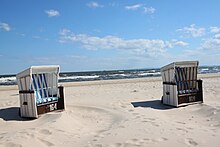
Tourism in Western Pomerania with its islands of Rügen and Usedom has developed dynamically since the reunification of Germany. Double-digit growth rates in capacity and number of guests with simultaneous expansion of the infrastructure were recorded. A peak value was reached in 2003 with 25.9 million overnight stays. However, the curve of the increase flattened noticeably and went into the red for the first time in 2004. Since 2005 there have been growth rates again. The official statistics in 2006 showed over 24.7 million overnight stays for all of Mecklenburg-Western Pomerania . In 2007, with 26.3 million overnight stays, the highest result since the statistics were introduced in 1991 was achieved. Western Pomerania - without Rügen and Hiddensee which achieved 8.9 percent - was above the national average with an increase of 6.8 percent in overnight stays. In addition, according to experts, there is another high number of overnight stays on the so-called "gray accommodation market", for example through holiday apartments in residential areas or free accommodation. Around two thirds of the overnight stays in MV are in Western Pomerania with the islands as tourist strongholds. The proportion of foreign guests is also rising steadily, but was still at a low level in 2007 at 2.7 percent.
There are four regional tourism associations in Western Pomerania: the Rügen Tourism Association, the Usedom Island Tourism Association, the Western Pomerania Tourism Association (for the mainland coast) and the Fischland-Darss-Zingst Tourism Association. All associations are members of the Mecklenburg-Western Pomerania Tourism Association, the regional association, which in turn is a member of the German Tourism Association (DTV).
Culture
The culture of Pomerania is best reflected in the urban area in the world cultural heritage " Historic Old Towns Stralsund and Wismar ". In rural areas, numerous castles, manor houses and village churches are being rebuilt in their old glory, others are still waiting to be rescued. The Pomeranian State Museum in Greifswald, the cultural history comprehensively. A well beyond the local area importance and the Cultural History Museum in Stralsund , which in the mid-19th century with significant participation of neuvorpommerschen municipal levels as a museum for the administrative district of Stralsund founded has been. A large part of the archival records is kept in the Greifswald State Archives , which between 1990 and 1997 was therefore also called the "Vorpommersches Landesarchiv". Further parts of the archival and museum remains are kept in today's Polish facilities in Szczecin, which is justified by history up to 1945. Furthermore, the Society for Pomeranian History, Archeology and Art, the Historical Commission for Pomerania and the Working Group for Pomeranian Church History, all based in Greifswald, strive to preserve the historical heritage of the area within the framework of Pomeranian national history.
Cities
language
In Western Pomerania the Western Pomeranian dialect of East Low German is still often spoken. This can be found in German-language literature in particular in the two fairy tales by the Brothers Grimm " Von dem Fischer un syner Fru " and " Von dem Machandelboom " as well as in the poem "Mine Heimat", which was later set to music ("Where the Baltic waves trek to the beach" ), in which the Barther poet Martha Müller-Grählert describes her homeland in Western Pomerania.
Well-known Western Pomerania
- Ernst Moritz Arndt (historian, politician, writer)
- Heinrich Bandlow (Low German writer)
- Rudolf Baier (museum director and librarian in Stralsund)
- Hermann Bendix (composer from Damgarten)
- Theodor Billroth (doctor)
- Julius von Bohlen-Bohlendorf (historian)
- Otto Bruchwitz (local history researcher)
- Johannes Bugenhagen (theologian, reformer)
- Hermann Burmeister (natural scientist)
- Christian Andreas Cothenius (doctor)
- Johann Carl Dähnert (Scholar)
- Franka Dietzsch (German discus thrower)
- Hans Fallada (writer)
- Karl Ludwig Fernow (writer)
- Caspar David Friedrich (Romantic painter)
- Matthias Friese (organist and organ builder)
- Jacob Friedrich Friese (organist and organ builder)
- Friedrich Matthias Theodor Friese (organist and organ builder)
- Johann Friedrich Eosander Freiherr von Göthe (master builder)
- Martha Müller-Grählert (poet, "Where the Baltic waves")
- Ariane Grundies (writer)
- Ulrich von Hassell (resistance fighter)
- Ernst Hilzheimer (GDR functionary)
- Wolfgang Koeppen (writer)
- Peter Kreeft (inventor, first closed diving suit)
- Ines Krüger (moderator)
- Carl Friedrich von Ledebour (botanist and Imperial Russian State Councilor)
- Otto Lilienthal (aviation pioneer)
- Helmut Losch (weightlifter)
- Hans Modrow (politician)
- Bernt Notke (painter, sculptor and workshop manager)
- Carl Pauli (teacher and researcher of the Etruscan language)
- Oskar Picht (inventor of the blind typewriter)
- Gustav Adolf Pompe (poet of the "Pomeranian Song")
- Johann David von Reichenbach (enlightener, reformer)
- Karl Rodbertus (economist)
- Heinrich Rubenow (Mayor, founder of the University of Greifswald)
- Philipp Otto Runge (Romantic painter)
- Karsten Sarnow (Mayor of Stralsund)
- Bartholomäus Sastrow (writer and mayor of Stralsund)
- Günter Schabowski (GDR functionary)
- Carl Wilhelm Scheele (chemist)
- Matthias Schweighöfer (actor)
- Johann Joachim Spalding (philosopher)
- Carola Stern (publicist, journalist)
- Manfred Stolpe (politician)
- Karin Struck (writer)
- Franziska Tiburtius (1843–1927) (doctor)
- Harry Tisch (GDR functionary)
- Nadja Uhl (actress)
- Christian Ehrenfried Weigel (chemist, pharmacist, botanist and mineralogist)
- Georg Wertheim (businessman, founder of the Wertheim Group )
- Witzlaw III. (Prince of Rügen, minstrel)
- Fritz Worm (local poet, author of the "Rügen songs")
- Bertram Wulflam (Mayor of Stralsund)
- Alwine Wuthenow (Low German poet)
- Toni Kroos (soccer player, German national player)
See also
- Western Mecklenburg
- Middle Mecklenburg
- Mecklenburg Lake District
- East Low German language
- Mecklenburg-Western Pomerania
- Pomeranian cuisine
- Pomeranian song
- Vorpommersche Dorfstrasse
- Schwedenstrasse
literature
- Earth description of the Prussian monarchy (F. Leonardi, ed.), Volume 3, Halle 1794, pp. 604–705 ( full text ).
- Land book of the Duchy of Pomerania and the Principality of Rügen . Edited by Heinrich Berghaus, fourth part, second volume, Anklam 1868 ( full text ).
- W. Deecke: The relationships of the West Pomeranian cities to the topology and geography of their surroundings . In: IX. Annual report of the Geographical Society Greifswald ; Greifswald 1905, pp. 170-200 ( full text ).
Individual evidence
- ↑ Regional Planning Association for Western Pomerania
- ↑ Journal for School Geography, Volumes 13-14, 1892, p. 67, [1]
- ^ Pommersche Landschaft.de
- ↑ Oswald Jannermann: "Slavic place and water names in Germany", 2009, page 56
- ↑ Martin Meier: Western Pomerania north of the Peene under Danish administration from 1715 to 1721. 2008
- ↑ Mecklenburg-Western Pomerania: Expert: District reform brought 4 billion euros in losses | Nordkurier.de . November 20, 2017 ( nordkurier.de [accessed November 20, 2017]).
- ↑ Shortage of skilled workers: DGB admonishes entrepreneurs in MV | Nordkurier.de. February 9, 2019, accessed February 9, 2019 .
- ↑ WORLD: Labor market: 3.4 million full-time earn less than 2000 euros gross . April 28, 2019 ( welt.de [accessed April 28, 2019]).
- ↑ Patrick Dahlemann - Parliamentary State Secretary for Western Pomerania - Government Portal MV. Retrieved September 24, 2017 .
- ↑ Vorpommern-Fonds - government portal MV. Retrieved October 4, 2017 .
- ↑ Budget debate : AfD wants to abolish the Vorpommern Commissioner | Nordkurier.de . October 4, 2017 ( nordkurier.de [accessed October 4, 2017]).
- ↑ Western Pomerania Council appointed - government portal MV. Retrieved April 12, 2018 .
- ↑ Page no longer available , search in web archives: Tourism: record result for 2007
- ↑ Gray overnight market: More and more overnight guests prefer to book a place to stay with private individuals via the Internet than in a hotel , Wirtschaftswoche , March 7, 2013



